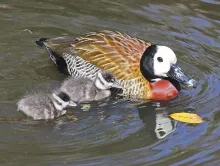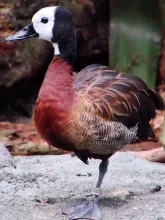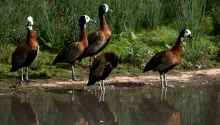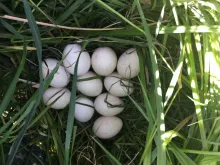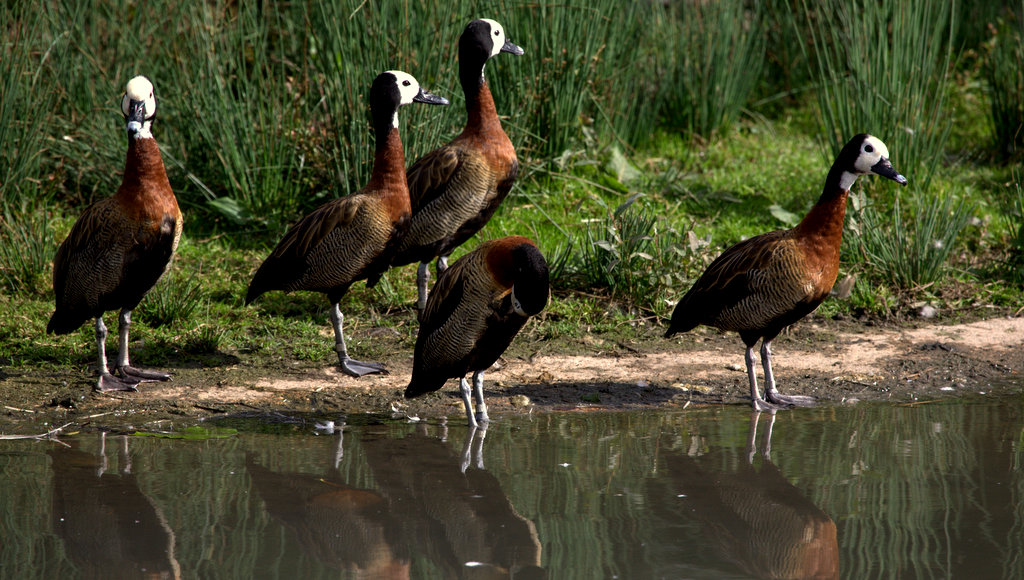
White-faced Whistling duck (Dendrocygna viduata)
Naamgeving
- Nederlandse naam:
- Witwang fluiteend
- Engelse naam:
- White-faced Whistling duck
- Duitse naam:
- Witwenpfeifgans
- Franse naam:
- Dendrocygne veuf
- Wetenschappelijke naam:
- Dendrocygna viduata
Taxonomische indeling
- Orde:
- Anseriformes
- Familie:
- Anatidae
- Onderfamilie:
- Dendrocygninae
- Geslacht:
- Dendrocygna
Beschrijving
- Uiterlijke kenmerken:
Male:
has white face, throat and forehead, from half crown, crossing behind the eyes to the throat, forming a beautiful contrast with black head back and upper nape. A chestnut wash goes down to the front, until the bottom and the hind neck, and on upper chest. Lower chest, belly and tail are black. Flanks are finely barred with black and white waves. Upperparts are dark brown, with wings bordered with buff, and particularly scapulars. Wings are dark brown. Bill is black with pale band at tip. Eyes are dark brown. Legs are grey.Female:
As male but smaller and a little duller.Juvenile:
Duller over all. Face and throat are grey or pale buff, chest is relatively dull chestnut. Chicks have dark olive-brown upperparts with large yellow patches on wings and back. Underparts are yellow. Face is streaked. Bill and legs are grey.
- Gedrag:
Sometimes mix with Fulvous whistling-ducks (Dendrocygna bicolor) and Black bellied Whistling duck (Dendrocygna autumnalis) in loafing areas, but within these aggregations they generally remain in groups of their own species. Form strong, probably life-long pair bonds.
Maten en Gewicht
- Lengte man:
- De man (woerd) van de White-faced Whistling duck heeft een lichaamslengte van ongeveer 38-48 centimeters. De vrouw (pop) heeft een lichaamslengte van ongeveer 38-48 centimeters.
- Gewicht man:
- Het mannetje weegt ongeveer 455-680 gram. Het vrouwtje weegt ongeveer 455-680 gram.
Het gewicht is notoir variabel en kan alleen als indicatie worden gebruikt!
- Notitie:
Whistling-ducks generally do well, either in pens or in a park with access to extensive water area and good natural cover. They are gregarious outside the breeding season, and groups may bully smaller duck species, so should be kept in large areas, in which other birds have room to escape. Most need shelter in severe weather and a well-sheltered pen with frost-free night quarters for winter is suggested, or plenty of ground cover and/or straw to stand on, as they are susceptible to frostbite. They may be kept fully-flighted in aviaries, and have also been kept full-winged in open pens, tending not to wander. Perches should be provided at an appropriate height for pinioned or wing-clipped birds. Commercial pellets and grain are suitable for feeding.
Elevated nest boxes are appreciated by most species, although pinioned birds will use ground-level boxes; boxes may be placed over water or land. Eggs may be incubated by bantams and ducklings may be bantam-reared. Many species have been successfully parent-reared in captivity. Pairs kept isolated and fully flighted in a covered pen, with high-hung nest boxes "seldom fail to rear broods". Whistling-duck species may hybridise with one another and therefore should be kept in separate enclosures, and hybridisation has also occasionally been reported with Rosy-billed pochard (Netta peposaca).
White-faced whistling-ducks are relatively hardy as adults, easy to keep and attractive in mixed collections. Plentiful water, area for seclusion and opportunities for perching should be provided. They require indoor accommodation in severe/frosty weather. These ducks may be fed grain, pellets, green food, bread.
White-faced whistling-ducks are fairly easy to breed. They sometimes nest in ground vegetation, may also use a ground-level or raised nest box or a hollow log screened with vegetation, usually laying in late April to June. Ducklings may be parent hatched and reared, or an incubator or broody may be used. Care and protection are important for the ducklings initially.
- Breeding:
- Het vrouwtje White-faced Whistling duck legt doorgaans zo'n 6-12 creamy white and not shiny eieren het broeden duurt 26-30 dagen.
- Kunstmatig broeden:
De ideale relatieve luchtvochtigheid voor het uitbroeden van de meeste watervogeleieren is 55% voor grondbroeders en 40% bij holenbroeders. De temperatuur is meestal 37,4° C. Stel ventilatie in zoals aanbevolen door de fabrikant van de broedmachine. Eieren moeten minimaal 4 keer per dag automatisch of met de hand worden gedraaid. Naarmate de vrucht zich ontwikkelt, verliest het ei water en wordt de luchtzak groter. Bij normale ontwikkeling van een ei met een incubatietijd van 26-30 dagen neemt de luchtzak ongeveer een derde van het ei in beslag, dit bij drie dagen voor uitkomst. Reinheid is van vitaal belang en idealiter moet de luchtvochtigheid worden verhoogd tot 65% nadat de eerste tekenen van uitkomst zichtbaar worden.
- Ringdagen:
- Aanbevolen passende ringmaat voor de White-faced Whistling duck is 11 mm.De gesloten pootring kan alleen aangebracht worden bij een jonge whistling duck van ongeveer 12 dagen oud.
- It doesn't matter what leg that you band, but it's good to have a consistent system. Suggested: Left leg = Female, Right leg = Male
- Onderhoudsvoeder:
-


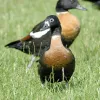


Floating full food for all sea ducks, green ducks, eider ducks and geese, especially in the moulting and breeding phase ideally suited. Packed with wholesome raw materials, natural vitamins and trace elements, this performance food with a protein content of 30% forms the basis for lifelong vitality.


